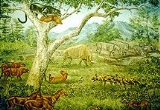
Pogonodon
Encyclopedia
Pogonodon is an extinct genus
of the family
Nimravidae
, subfamily Nimravinae endemic to North America
and Eurasia
during the Eocene
-Miocene
epochs (30.8—7.2 mya), existing for approximately ..
by Matthew (1910). It was assigned to Nimravidae
by Cope (1880), Merriam (1906), Thorpe (1920), Eaton (1922), Toohey (1959) and Bryant (1996); and to Nimravinae by Flynn and Galiano (1982), Bryant (1991) and Martin (1998).
Genus
In biology, a genus is a low-level taxonomic rank used in the biological classification of living and fossil organisms, which is an example of definition by genus and differentia...
of the family
Family (biology)
In biological classification, family is* a taxonomic rank. Other well-known ranks are life, domain, kingdom, phylum, class, order, genus, and species, with family fitting between order and genus. As for the other well-known ranks, there is the option of an immediately lower rank, indicated by the...
Nimravidae
Nimravidae
The Nimravidae, sometimes known as false saber-toothed cats, are an extinct family of mammalian carnivores belonging to the suborder Feliformia and endemic to North America, Europe, and Asia living from the Eocene through the Miocene epochs , existing for approximately .-Morphology:Although some...
, subfamily Nimravinae endemic to North America
North America
North America is a continent wholly within the Northern Hemisphere and almost wholly within the Western Hemisphere. It is also considered a northern subcontinent of the Americas...
and Eurasia
Eurasia
Eurasia is a continent or supercontinent comprising the traditional continents of Europe and Asia ; covering about 52,990,000 km2 or about 10.6% of the Earth's surface located primarily in the eastern and northern hemispheres...
during the Eocene
Eocene
The Eocene Epoch, lasting from about 56 to 34 million years ago , is a major division of the geologic timescale and the second epoch of the Paleogene Period in the Cenozoic Era. The Eocene spans the time from the end of the Palaeocene Epoch to the beginning of the Oligocene Epoch. The start of the...
-Miocene
Miocene
The Miocene is a geological epoch of the Neogene Period and extends from about . The Miocene was named by Sir Charles Lyell. Its name comes from the Greek words and and means "less recent" because it has 18% fewer modern sea invertebrates than the Pliocene. The Miocene follows the Oligocene...
epochs (30.8—7.2 mya), existing for approximately ..
Taxonomy
Pogonodon was named by Cope (1880). It was synonymized subjectively with Dinictis by Adams (1896) and Macdonald (1970); it was synonymized subjectively with NimravusNimravus
Nimravus is an extinct genus of the family Nimravidae, subfamily Nimravinae endemic to North America during the Oligocene epoch , existing for approximately .-Taxonomy:...
by Matthew (1910). It was assigned to Nimravidae
Nimravidae
The Nimravidae, sometimes known as false saber-toothed cats, are an extinct family of mammalian carnivores belonging to the suborder Feliformia and endemic to North America, Europe, and Asia living from the Eocene through the Miocene epochs , existing for approximately .-Morphology:Although some...
by Cope (1880), Merriam (1906), Thorpe (1920), Eaton (1922), Toohey (1959) and Bryant (1996); and to Nimravinae by Flynn and Galiano (1982), Bryant (1991) and Martin (1998).

